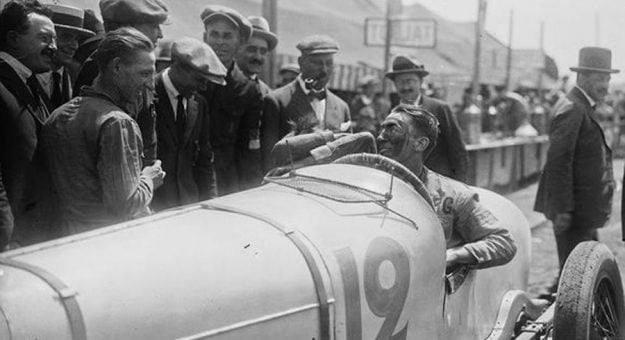Jimmy Murphy rose from the abject poverty of San Francisco’s Irish slums to stardom during the Golden Era of American auto racing — the board -track racing of the roaring 20s.
On wooden bowls with banking of up to 50 degrees and turns as high six-story buildings, drivers fought for supremacy in excess of 100 mph with only bicycle tires gripping the oil-soaked planks.
The drivers’ epic bravery captured the public’s imagination and earned them celebrity equal with stick-and-ball heroes. There was Tommy Milton, Ralph DePalma and Pete DePaolo. Murphy outshined them all.
Murphy became enamored with motorsports when his uncle, who took him into his Los Angeles home following his mother’s death during the 1906 San Francisco Earthquake, bought him a motorcycle.
The youngster became a skilled mechanic and right out of high school opened a shop that catered to Los Angeles motorcyclists.
His mechanical expertise led to a riding mechanic’s position with the Duesenberg team, where Milton took a liking to him and encouraged Fred Duesenberg to give him a chance behind the wheel.
That came at the 1920 season opener on the new Beverly Hills board track. Murphy took the pole and won the 250-mile race with a world record speed of 103.204 mph.
In only four-and-a-half years, Murphy rose to the ranks of an American icon. He won half of the AAA Championship board-track races in which he competed and finished on the podium in 33 of the 53 races.
Murphy won the Indianapolis 500 pole twice, and in 1922 became the first driver to win the 500 from the pole. In 1924, after his death in Syracuse, N.Y., he posthumously attained the AAA national championship.
For all his American racing accomplishments, however, perhaps Murphy’s finest hour came 100 years ago when he became the first American driver to win a European Grand Prix. He remains the only American to win a Grand Prix in an all-American car.
His historical achievement happened on July 25, 1921, in Le Mans, France. Spark plug magnate and French immigrant Albert Champion wanted his adopted home country to shine and encouraged Duesenberg to enter the first post-World War II Grand Prix. The always cash-strapped Duesenberg agreed when Champion paid the way.
Although they faced the world’s best automotive competition, the four Duesenberg entries enjoyed a significant advantage with Duesenberg’s latest innovation, four-wheel hydraulic brakes. The brakes allowed the Duesenberg drivers to charge deep into the turns, but in the beginning they were problematic.
A week before the race, while practicing on the unfamiliar 10.5-mile course a horse wandered onto the track in front of Murphy. He jumped on the brakes. They locked and the car slid into a deep ditch upside down, with Murphy and teammate Louis Inghilbert pinned underneath.
Both landed in the hospital. Murphy, with broken ribs and various internal injuries, was not expected to race. But much to the consternation of French officials, two hours before race time Murphy appeared, bandaged from his waist to his shoulders.
The crew hoisted him into the cockpit and with mechanic Ernie Olson alongside, Murphy roared into the lead on the second lap.
Olson later recalled the race being one of the most harrowing he’d ever ridden in. Gravel thrown up by other cars sounded like, “… machine gun fire as it pounded our car as well as Jimmy and I.”
DePaolo, who won the 1925 Indianapolis 500, rode with his uncle, DePalma, at Le Mans. He called Murphy’s drive that day the best of his life as he crossed the finish line 15 minutes ahead of DePalma.
When he rolled to a stop, the partisan French crowd greeted the victorious Murphy with silence. They had expected their beloved Ballots to win easily.
Owner Ernest Ballot ranted that the Duesenbergs were junk, avowing if the race had continued the Ballots would’ve taken the win.
Fellow Frenchman and 500 competitor Albert Guyot silenced Ballot, saying, “There’s only one winner in any race: the man who gets home first.”
